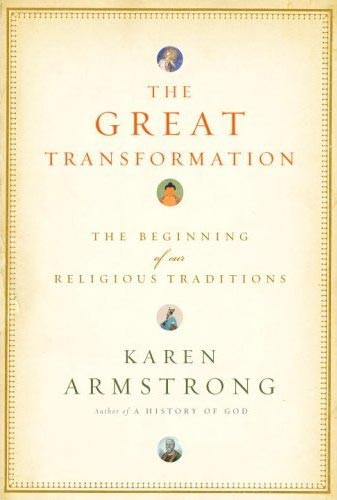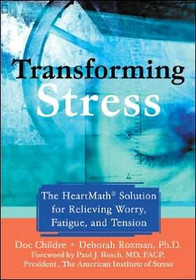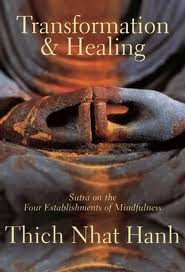- Home
- Books & More
- BOOKS (A - C)
- COMPARATIVE RELIGION
- The Great Transformation
Categories
Product Description
The Beginning of Our Religious Traditions
Karen Armstrong reveals how the sages of this pivotal "Axial Age" can speak clearly and helpfully to the violence and desperation that we experience in our own times.
In the ninth century BCE, the peoples of four distinct regions of the civilized world created the religious and philosophical traditions that have continued to nourish humanity to the present day: Confucianism and Daoism in China, Hinduism and Buddhism in India, monotheism in Israel, and philosophical rationalism in Greece.
Later generations further developed these initial insights, but we have never grown beyond them. Rabbinic Judaism, Christianity, and Islam, for example, were all secondary flowerings of the original Israelite vision.
Armstrong traces the development of the Axial Age chronologically, examining the contributions of such figures as the Buddha, Socrates, Confucius, Jeremiah, Ezekiel, the mystics of the Upanishads, Mencius, and Euripides. All of the Axial Age faiths began in principled and visceral recoil from the unprecedented violence of their time.
Despite some differences of emphasis, there was a remarkable consensus in their call for an abandonment of selfishness and a spirituality of compassion. With regard to dealing with fear, despair, hatred, rage, and violence, the Axial sages gave their people and give us, Armstrong says, two important pieces of advice: first there must be personal responsibility and self-criticism, and it must be followed by practical, effective action.
In her introduction and concluding chapter, Armstrong urges us to consider how these spiritualities challenge the way we are religious today. In our various institutions, we sometimes seem to be attempting to create exactly the kind of religion that Axial sages and prophets had hoped to eliminate. We often equate faith with doctrinal conformity, but the traditions of the Axial Age were not about dogma. All insisted on the primacy of compassion even in the midst of suffering. In each Axial Age case, a disciplined revulsion from violence and hatred proved to be the major catalyst of spiritual change.
Dimensions: 9.48" x 6.6"
Details: Hardcover, 469 pages
Author: Karen Armstrong
Testimonials
From Publishers Weekly
Having already recounted "a history of God," the redoubtable Armstrong here narrates the evolution of the religious traditions of the world from their births to their maturity. In her typical magisterial fashion, she chronicles these tales in dazzling prose with remarkable depth and judicious breadth. Taking the Axial Age, which spans roughly 900 B.C.E. to 200 B.C.E., as her focal point, Armstrong examines the ways that specific religious traditions from Buddhism and Confucianism to Taoism and Judaism responded to the various cultural forces they faced during this period. Overall, Armstrong observes, violence, political disruption and religious intolerance dominated Axial Age societies, so Axial religions responded by exalting compassion, love and justice over selfishness and hatred. Thus, the central Buddhist and Jain practice of ahimsa, doing no harm, developed in India in reaction to the self-centeredness of Hindu ritual, and Hebrew prophets such as Amos proclaimed that justice and mercy toward neighbors offered the only correct way of walking with God. Accounts of the world's religions often present them as discrete entities developing apart from each other in a vacuum. Armstrong's magnificent accomplishment offers us an account of a violent time much like ours, when religious impulses in various locations developed practices of justice and love.
From The Washington Post's Book World/washingtonpost.com
In 1948, the German philosopher Karl Jaspers coined the term "Axial Age" to denote an astonishing era, from roughly 900 B.C. to 200 B.C., in which the foundations of the world's great religions were laid. This was the time of Socrates, Elijah, Siddhartha, Confucius. In her magisterial new exploration of the era, Karen Armstrong argues that all Axial Age traditions emphasized justice and were committed to the practice of "disciplined sympathy" and compassion. The Great Transformation is Armstrong at her best -- translating and distilling complex history into lucid prose that will delight scholars and armchair historians alike, drawing connections between the distant past and our own religious practices, suggesting that the antidotes to some of contemporary religion's excesses lie in the roots of the religious traditions themselves.
The Axial Age was anticipated, Armstrong writes, by the prophetic priest Zoroaster. Outraged at the violence of the Aryan warrior culture, Zoroaster conceived of the cosmos as a battle between the forces of good and evil, and he envisioned a great judgment that would eventually culminate in a world of peace and justice. Zoroastrianism is now known to us largely as a historical relic, but his "passionately ethical vision" and his determination to find a spiritual idiom that promoted peace bore fruit in the religious traditions of the Axial Age.
Other sages also emerged from the conflicts of the era: In India, the Axial Age coincided with the collapse of the Harappan civilization; in Greece, spirituality and philosophy flourished as the Mycenaean kingdom gave way to the Macedonian empire. Socratic philosophy was forged in the brutality of the Peloponnesian War. Breaking sharply from the Greek tradition of vengeance, Socrates argued that retaliation was always unjust and that the key to enlightenment and social virtue was acting with forbearance toward everyone, friend or enemy. The Buddha similarly taught that focusing on the self led to envy, conceit and pride; only a movement into "no self" would lead to "non-distress" and "unhostility."
When the kingdom of Israel, profitably allied with Assyria, failed to care for its poor, the prophet Amos warned that God would turn against his chosen people if they did not clean up their act. Amos, Armstrong writes, exemplified kenosis, or self-emptying: He believed that "his subjectivity had been taken over by God," so it was not Amos offering radical prophecies but God himself. God had experienced the injustices committed by Israel as painful and humiliating acts against him -- so Amos was calling the Israelites to feel, as their God felt, the sufferings of others.
Though this is a study of ancient history, Armstrong has a present-day agenda. We also live in a time of great social transformation and unrest, and, like the Axial sages, we should foster compassion, self-emptying and justice.
She notes that compassionate spirituality leaves room for doctrine: "This is not to say that all theology should be scrapped or that the conventional beliefs about God or the ultimate are 'wrong.' . . . The test is simple: if people's beliefs -- secular or religious -- make them belligerent, intolerant, and unkind about other people's faith, they are not 'skillful.' If, however, their convictions impel them to act compassionately and to honor the stranger, then they are good, helpful, and sound. This is the test of true religiosity . . . . Instead of jettisoning religious doctrines, we should look for their spiritual kernel."
Armstrong's emphasis on the things that unify Hinduism, Socratic philosophy, Judaism and Confucianism has just a whiff of the old colonialist approach to "world religions," reveling in religions' resemblances without sufficiently acknowledging their particularities. (The Brits who "discovered" Hinduism cast it, and every other religion, in terms that looked a lot like Christianity. Armstrong does much the same thing in reverse, casting Judaism and its spiritual descendants in terms that look a lot like Buddhism.) This approach fails to recognize the ways in which Buddhist compassion and Hindu compassion and Christian compassion and Jain compassion may meaningfully differ. Without an honest appraisal of those differences, it is hard to evaluate, say, the difference between the morality of the euthanasia advocate and the radical pro-life Catholic. Whose compassion trumps, that of George W. Bush or of John Paul II?
And yet, Armstrong's call to rededicate our religious selves to compassion, other-directed love and service is downright rousing. People from many different faiths will close this book reminded of the value their tradition places on compassion and recommitted to expressing it in their own religious idiom.
Reviewed by Lauren F. Winner
From Bookmarks Magazine
If you've already written God's biography (A History of God), surely it's a cakewalk to tackle the era before His ascendancy in theological affairs. But making sense of four disparate cultures and religious traditions in the space of 400 pages proves to be a risky proposition for Armstrong. Critics agree that her central theme, "the gradual elimination of violence from religion" (New York Times), makes for compelling reading, as does her weaving together of similarities among disparate faiths. Though her analysis shines, many reviewers feel the book suffers from too broad a focus; centuries are foreshortened, and even her supporters feel her conclusion doesn't do the book justice. With classic titles like The Battle for God and Islam: A Short History in her bibliography, the "runaway nun" remains our preeminent writer on popular religion, but this tome might best be reserved for her hardcore followers.
From Booklist
The foremost English-language historian of religion today, whose A History of God (1993) has become the standard popular work on the great monotheisms, expands upon German philosopher Karl Jaspers' characterization of the long period preceding the rise of Rome--900 to 200 B.C.E.--as the Axial Age. That at first puzzling geometric metaphor crystallizes Jaspers' sense, which Armstrong clearly shares, of that immense era as pivotal in human consciousness. During it the major religious traditions began and refined the moral attitudes they manifest to this day. Commencing as tribal and aristocratic, the pre-Christian religions became personal and democratic as the realm of divinity came to be perceived as transcendent. Most important was the development of nonviolence as a holy ideal, not least because the early religions initially employed violence in their rituals and justified violence by their adherents. The Aryans of northern India and the Chinese, both initially violent, attempted to constrain belligerence and avert chaos by fashioning what became Hinduism and Buddhism, and Confucianism and Taoism, respectively. Meanwhile, the smaller civilizational formations of the Jews and the Greeks responded to experiences of, respectively, periodic near-obliteration and social collapse with monotheism and philosophical rationalism, respectively. Armstrong tells this huge story in 10 chapters that each relate historically parallel developments among the Indians, Chinese, Greeks, and Jews. Magisterially but companionably, she unfolds the successive movements that molded religious consciousness in each nation, explaining them with such clarity that this book ranks with A History of God as one of her finest achievements and an utterly enthralling reading experience. Ray Olson
Praise for Karen Armstrong:
åÒArmstrong at her beståÐtranslating and distilling complex history into lucid prose that will delight scholars and armchair historians alike.åÓ
åÐLauren F. Winner, The Washington Post Book World
åÒHer conviction, passion and intelligence radiate throughout the book, making us feel the urgency of the ideas it seeks to convey.åÓ
åÐCharles Matthews, Baltimore Sun
åÒA tour de force. . . . She has dedicated herself to understanding the most prominent world faiths and explaining them to a secular/postsecular society."
åÐJane Lampman, The Christian Science Monitor
åÒPerhaps her most ambitious work. . . . Without overlooking the differences between religions, Armstrong emphasizes their common call for compassion.åÓ
åÐLisa Montanarelli, San Francisco Chronicle
åÒA lucid, highly readable account of complex developments occurring over many centuries. . . . A splendid book.åÓ
åÑWilliam Grimes, The New York Times
åÒAn utterly enthralling reading experience. . . . This book ranks with A History of God as one of her finest achievements.åÓ
åÑBooklist
åÒIn her typical magisterial fashion, she chronicles these tales in dazzling prose with remarkable depth and judicious breadth.åÓ
åÑPublishers Weekly
"The Great Transformation can serve the needs of new readers interested in a popular work that synthesizes scholarship. . . . [U]seful to anyone seeking an integral sense of world religions."
åÑThe Globe and Mail
"Karen Armstrong is a genius."
åÑA. N. Wilson, author of Jesus: A Life
"Armstrong is a lucid writer with a knack for synthesizing vast quantities of research."
åÑThe Globe and Mail
"ArmstrongåÕs writing continues to offer a religious mirror and a cultural vision."
åÑAmazon.com
"Armstrong has a dazzling ability: she can take a long and complex subject and reduce it to the fundamentals, without oversimplifying."
åÑThe Sunday Times
åÒArmstrongåÕs erudition is truly impressive. . . . Few people are better qualified to explain that what so often divides us ought to unite us instead.åÓ
åÑCleveland Plain Dealer
åÒBroad, eloquent storytelling.åÓ
åÑThe Wall Street Journal
åÒHer conviction, passion and intelligence radiate throughout the book, making us feel the urgency of the ideas it seeks to convey.åÓ
åÑNew York Sun
åÒThis could very possibly be one of the greatest intellectual histories ever written.åÓ
åÑLibrary Journal (starred review)
åÒA book of the magnitude of The Great Transformation can only be considered authoritative.åÓ
åÑCharleston Post & Courier
åÒOn prominent display in this book are ArmstrongåÕs usual virtuesåÐwide knowledge, meticulous research, a superb appreciation for the beauty and power of religious and philosophical ideasls, and general readability.åÓ
åÑShambhala Sun
åÒThis magisterial work, continuing Karen ArmstrongåÕs mission to explore the place and purposes of religions in the modern world, follows in the stream of her books on Christianity, Judaism, Islam, and Buddaism.åÓ
åÑSpirituality & Health
About Karen Armstrong
Karen Armstrong is one of the most provocative, original thinkers on the role of religion in the modern world. Formerly an instructor at London's prestigious Leo Baeck College for the Study of Judaism, she is author of the international best seller, The History of God. Armstrong is a former Roman Catholic nun who left the convent to pursue a degree in modern literature from Oxford University. She has since taught Modern Literature at London University and served as head of the English Department in a girls' secondary school.
During 1983, Armstrong worked in the Middle East on a six-part TV series on the life and work of St. Paul, which was shown on Britain's Channel Four Television. Her other television work has included Varieties of Religious Experience (1984), in which she interviewed people of different faiths, Tongues of Fire (1985), in which she discussed religious poetry, and in 1996, the PBS series "Genesis: A Living Conversation," with Bill Moyers.
Custom Tab
Returns Policy
Your satisfaction is extremely important to us. If, for any reason, you are not satisfied with an item you ordered from us, you can return it for a full reimbursement - minus any re-stocking fees (see below), any time within 30 days of your receipt of an item. We'll also refund the shipping cost if the return is a result of our error. We cannot reimburse your shipping costs for any item that is returned at your discretion. Here are the general guidelines for returning products:
All items must be in their original, new, condition.
CD's, VHS tapes, audio books, and DVD's must by unopened, unless they are defective.
There is up to a 15% re-stocking fee for returned items - depending on the item. Many items do not have a re-stocking fee. Our distributors charge this fee, not us.
Note: Please call us toll free at 866.665.7765 Monday - Sunday 9 am - 6pm PST, or email us for an RMA# BEFORE returning any items.
Items shipped directly from the manufacturer or a distributor may need to be returned directly to the manufacturer or distributor, and NOT to us. Therefore please call us before returning any items.
We will notify you via e-mail of your refund once we've received and processed the returned item. You can expect a refund in the same form of payment originally used for purchase within 7 to 14 business days of our receiving your return. If your return is not due to our error, the refund will not include shipping costs.
Shipping
Shipping within the United States
You will receive a confirmation of your order via e-mail, usually within 15 minutes. Please make sure that your email spam program is set to receive emails from "@innerpath.com". If you do not receive an order confirmation within 15 minutes, please also check your junk mail folder. Orders are usually shipped within 2-3 business days. In the United States we ship U.S. Postal Service Priority Mail or United Parcel Service. Please note that items in your order may ship separately from different locations. So allow sufficient time for all parts of your order to arrive. If you have any questions or concerns about where an order might be, please call us at 866.665.7765 Monday - Sunday 9 am - 6pm PST, or email us. We will be more than happy to assist you.
Shipping outside the United States
For overseas and Canadian shipping, please check "Email Me My International Shipping Quote $0.00". We will then email you the options for shipping to your country. You then email us back to let us know which method you would prefer, and at that time we will ship your order and charge your credit card. Please note: If you select a shipping method that is not insured, after we ship it from the US we have no control over what the postal service in your country will do. Therefore, unfortunately we cannot be responsible for lost packages that were not sent by insured post. If you need phone assistance please call us at 530.470.6057 Monday - Sunday 9 am - 6pm PST.
 Loading... Please wait...
Loading... Please wait...







